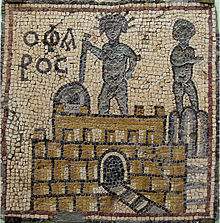Olbia (Libya)


Olbia or Theodorias was a Roman and Byzantine city in North Africa , in what is now Libya in the Kyrenaica region . The modern name of the archaeological site is Qasr Libya after the castle (Qasr) from the Islamic period or Lebia as a corruption of the old name Olbia.
location
The site is on a hill near Qasr Libya, on the main road from Al-Marj to Al-Baida , at the junction to Marawah in the south.
history
After the destruction by the Vandals and after attacks by Laguatan (Lwatae) nomads, Olbia was re-established as Polis Nea Theodorias by Emperor Justinian I in 539 in honor of his wife Theodora I , who spent her youth in nearby Apollonia would have.
Olbia belonged to the Exarchate of Africa until it was conquered by the Arabs in 643/644 during the Islamic conquest of North Africa .
There were two Byzantine churches in the city. The western one was integrated into the Qasr, which serves as a museum. The eastern church was excavated by Richard Goodchild in the mid-1950s . Fifty small mosaics with a total area of 10.5 mx 6 m were embedded in square holes in the floor of the entrance hall . Spiritual beings of the pre-Roman era were depicted, as well as Christian symbolism, the re-establishment and beautification of the city by Theodora, animals, the four rivers of paradise from Genesis : Geon ( Nile ), Physon ( Ganges ), Euphrates and Tigris , and the well-known World. In addition to gods and goddesses, there are images of human figures, horsemen, musicians, sailors (including a merman with a trident), sea monsters, birds, ostriches, crocodiles, bulls, zebras and leopards. Compared to the official imperial art of that time, the type of representation appears a bit crude, but lively and very colorful. The fifty mosaics were brought to the museum in the Ottoman-Italian fortress opposite the church and exhibited there.
literature
- Richard Goodchild: The Great, newly discovered mosaic floor of Qasr el-Lebia. London Illustrated Evening News, December 14, 1957.
- Gwyn Williams: Green Mountain - an informal guide to Cyrenaica and its Jebel Akhdar . Faber and Faber, 1963.
Web links
- Theodorias (Qasr Libya) livius.org
- Qasr Libya ('Libya Castle') temehu.com
Individual evidence
- ^ John Beckwith: Early Christian and Byzantine Art Yale University Press, New Haven, Connecticut 1993, ISBN 0-300-05296-0 , p. 74 .
- ↑ Olivier Pliez (ed.): Qasr Libya (Olbia-Theodoria), Le Petit Futé Libye , Paris, ISBN 2-7469-2276-2 , p. 241 (French).
- ↑ James Azema: East of Barce, Libya Handbook: The Travel Guide. Bath 2000, ISBN 1-900949-77-6 , p. 163 (Footprint Travel Guides).
Coordinates: 32 ° 30 ' N , 20 ° 54' E